Vol.41 A.F. Building Management Co., Ltd. and Uchiyama Landscape Construction Co., Ltd.
The Greening of ACROS Fukuoka, an “Urban Mountain”

| Date of Interview | October 25, 2022 |
|---|---|
| Interviewees | A.F. Building Management Co., Ltd., General Affairs Department, Assistant Manager, Atsuko Kawano Uchiyama Landscape Construction Co., Ltd., Kyushu Branch Office, Arborist Ayami Nose |
First of all, please give us a brief overview of ACROS Fukuoka.
Kawano: ACROS Fukuoka is a public–private complex that was established in 1995 on the site of the former Fukuoka Prefectural Government Building in Fukuoka City’s central Tenjin district as a hub of international, cultural and information exchange. The project began in 1981 as a development on the site of the former Prefectural Government Building, and the acronym ACROS in the new building’s name stands for “Asian Crossroads Over the Sea.” This complex represents Fukuoka, a city that is expected to strengthen its ties with Asia across the sea and serve as a crossroads.
1In 1991, a proposal by the Dai-ichi Mutual Life Insurance Company and Mitsui Fudosan Co., Ltd. was selected in a competition, and the basic concept of the project was defined by world-renowned architect Emilio Ambasz under the supervision of landscape architect Michio Tase based on the “Step Garden” concept, which promotes a sense of unity with neighboring Tenjin Central Park.
At that time, in response to a public call for proposals, six groups submitted their ideas, leading to the adoption of the “Step Garden,” which would replace the existing ground-level space with a new open space to create a lush green environment blending into the adjoining Tenjin Central Park. In addition, since many public facilities for the prefecture's residents, including a multi-purpose hall, were to be located on the lower floors, this proposal was selected on the basis of its excellent organic linkage and on the ease of circulation it promised between the public and private sectors by way of the atrium, for which it was expected to attract a large number of visitors.

The construction site was the center of the prefecture’s administration for 100 years from when the Fukuoka Prefectural Government Building moved from Fukuoka Castle to Tenjin in 1876, until its relocation to its current location in Higashikoen in Hakata Ward in 1981. Accordingly, the site can be said to enjoy a high degree of public recognition and status. In addition, the north side of the site faces Meiji-dori, the main street of Fukuoka City, while the south side adjoins Tenjin Central Park and the Fukuhaku Promenade, which integrates Tenjin with the Nakasu-Kawabata district of Hakata, giving the neighborhood of the complex the two distinct façades of a business district and an urban amenity zone. In addition, ACROS Fukuoka’s underground mall is directly connected to Tenjin Station on the Fukuoka City Subway and to the Tenjin Underground Mall, a major shopping center, making it a prime location in Fukuoka, with easy access to the rest of the city.
A facility designed to coexist with nature and create a space that enriches the mind, ACROS Fukuoka is integrated with Tenjin Chuo Park, and the building itself can be regarded as a mountain within the city. Large-scale building greening has been applied to the stepped slope with the aim of creating an urban oasis that fills visitors with a sense of tranquility and relaxation. Also, because the complex has an appearance reminiscent of a natural mountain, it has been nicknamed Mt. ACROS.

Could you tell us about the tree species and the soils of Mt. ACROS?
Kawano: The vegetation for the building’s rooftop greenery was planted in the course of a two-year experiment, covering a rooftop green area of 5,400 m2 from the 2nd to the 14th floors, and including about 200 different species of shrub and tree seedlings. The building was configured to resemble a single mountain, and the planting was designed to allow people to enjoy the changes in foliage from season to season. At time of completion, the green area included 76 species totaling 37,000 individual plants. Of the main types of plantings, we used 32 plant species to create 15 types of okarikomi*, with each of the types based on one of four arrangements, namely mixed evergreen, mixed deciduous, mixed evergreen/deciduous, and mixed evergreen/semi-evergreen. Moreover, for the plants protruding from the okarikomi, we used 23 species of trees including plum, maple, and Japanese apricot, and to cover the walls we used five species of drooping plants including shore juniper and cotoneaster. The number of tree species has gradually increased through supplemental planting and the addition of species carried by wild birds such as Japanese grosbeaks, Japanese tits, white-cheeked starlings, and meadow buntings, and currently stands at about 200 species. We hope to eventually increase the number of tree species to between 350 and 400, which is close to the number growing wild in the mountains of Kyushu.
※Okarikomi (mass trimming) is a method of planting a variety of different types of trees together and pruning them uniformly as a single large cluster.

The plants are rooted not in natural soil, but in an artificial soil called Aquasoil, which is made from a rock called perlite. In selecting the soil, we comprehensively considered (1) the specific gravity (slab load), (2) the product’s performance (potential sustainability for 60 years), (3) aging, (4) water retention, (5) drainage performance, (6) wind resistance, (7) management, (8) workability, and (9) cost, and the selection of Aquasoil was based on the results obtained from mock-up tests.
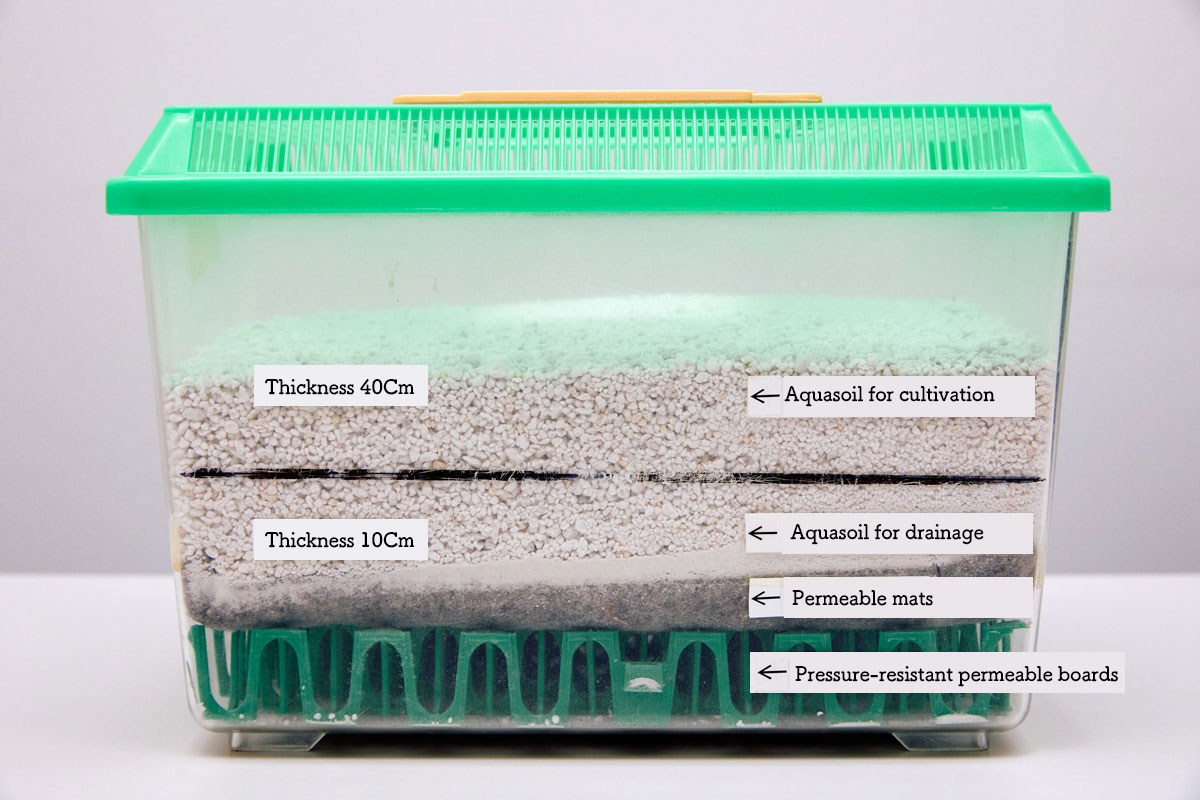
Ordinary roots growing in Aquasoil become more bristle-like, resulting in friction with the soil, so that even with a soil thickness of only 50 cm, the plants are well anchored. Because the roots stop growing at a certain point, they do not extend far enough to cause damage to the building. The weight of Aquasoil is about one-third that of the same volume of regular soil, and the balance between water retention and drainage can be freely controlled by adjusting the mix of these two materials. When it rains, the plants can store sufficient water to meet their needs for the next 60 days, and excess water slowly trickles down through the Aquasoil to the lower floors, creating a drainage system similar to that of a real mountainside. In order to increase the rainwater retention capacity, artificial soil is also used in areas beyond the planted areas, and no pesticides or fertilizers are applied. Fallen leaves that have accumulated on the ground form a topsoil layer that functions as a habitat for microorganisms and insects. This creates an ecosystem in which birds gather to feed on the insects, drop seeds and berries on the ground, and thereby allow new plants to spring up.

What measures are you taking to mitigate the effects of sudden strong winds, which are on the increase due to climate change?
Nose: In response to the rising incidence of abnormal weather conditions in recent years due to climate change, we have studied weather data for the past 30 years with a view to implementing strong wind countermeasures for rooftop planting up to 60 m above ground level to prevent trees from toppling over, being blown away, or falling onto the road below. The main measures we are planning are to reduce the wind pressure on each tree by planting several trees close together, and at the same time, to make each overall okarikomi windproof as a means of reducing the wind velocity in the planting areas on each floor. In addition, as a countermeasure for periodic strong winds, the density of plantings is increased toward both the east and west ends of the building, and a certain area is planted exclusively with mixed evergreens to prevent the scattering of fallen leaves, while the top floor vegetation is restricted to ground cover plants only.
Every year during the typhoon season, we prune and remove any dead branches from the trees and reuse the pruned branches as bio-nests instead of disposing of them. Bio-nesting is a process of weaving the pruned branches in a circular pattern, beginning with the thickest ones, like a bird's nest. Overhanging branches are cut, and the thinner branches, fallen leaves, and cut weeds and grasses are piled into a dome shape inside the assembled branches and left to decompose and turn into compost, which can later be returned to the surrounding trees.

At ACROS Fukuoka, we place an emphasis on maintaining a natural appearance, so we carefully trim the trees with small shears and avoid using large shears. We very rarely apply pesticides, which means that we try to catch all insect and other pests by hand. Also, fallen leaves and weeds are not removed but are left in place in an effort to recreate the look of a natural mountain.
What is the drainage and irrigation plan?
Kawano: Rainwater is absorbed and retained by the 50 cm-thick layer of artificial soil, but when precipitation is heavy, excess rainwater gradually percolates downstairs through the aerated permeable layer laid over the waterproof protective layer and flows down to the ground level into the vegetation and pond. In addition, the drainage system is designed to discharge excess water into the Yakuin-Shinkawa River to improve the efficiency of drainage in the event of heavy rainfall. This arrangement is also modeled on natural mountain drainage systems.
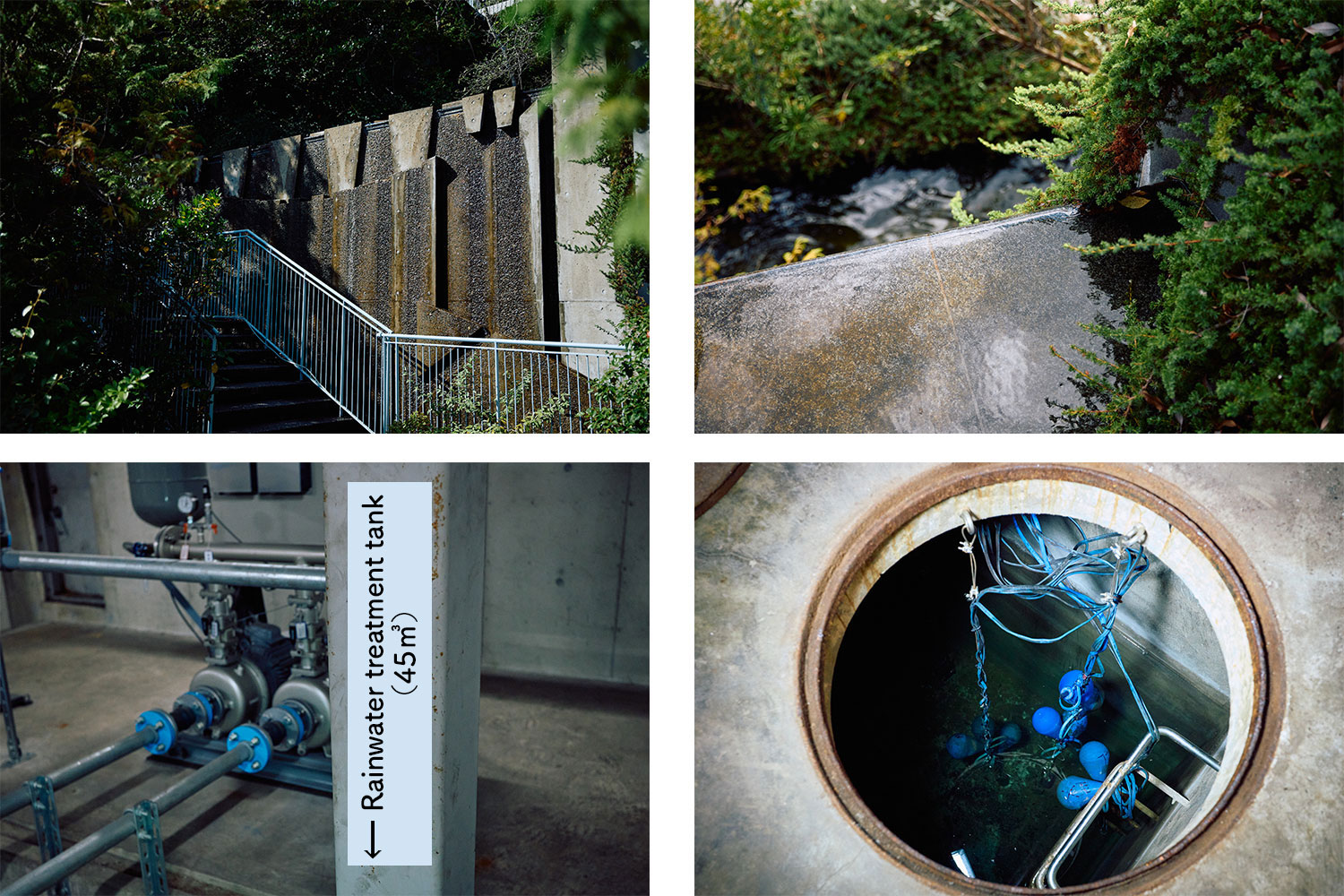
With regard to the irrigation plan, the rainwater that falls on the top floor is stored in a 600-ton storage tank on the fourth basement floor, and this water is applied for irrigation by means of a sprinkler system.
Generally, a single sprinkler application (using 300 tons) can supply the plants with enough water to last for one month, but the timing of such watering is determined by human observation of the plants’ condition. The system is not designed to be used as a regular automatic irrigation system. In fact, in most years the sprinklers are used for watering two to three times a year around the time of the Bon Festival as a measure against extreme summer heat, but other than that, natural precipitation is sufficient to keep the plants supplied with water. Lastly, excess rainwater from the tank is passed through a filtration system to produce recycled water, which is then used to flush the toilets throughout the building.

Is Mt. ACROS also effective in mitigating the heat island effect?
Kawano: According to a thermal environment measurement survey conducted by Kyushu University, Nippon Institute of Technology, and Takenaka Corporation, infrared thermometer measurements made during the daytime in mid-summer showed that temperatures on concrete surfaces reached over 50ºC, while the maximum temperature of the green vegetation surface was about 15ºC lower at 38ºC. (Please see the figure.) Moreover, the surface of Mt. ACROS displayed a sharp drop in temperature during the evening hours, and throughout the five days of measurements, it was confirmed that the surface of the mountain at night was equal to or cooler than the temperature of the surrounding air.
Transpiration by plants (the release of water into the atmosphere from plant surfaces in the form of water vapor) has the effect of removing heat from the surrounding air, thereby restraining the rise in ambient temperatures. According to data obtained from observations of changes in temperature around the east, west, south, and north sides of Mt. ACROS, although the temperature should ordinarily be highest on the south side where the sunlight throughout the day is most intense, the observations revealed that the temperature on the south side, where the Step Garden is located, was lower than that on the north side. We consider that the greenery reduces the temperature rise around the building and also reduces the heat penetration into the building’s interior, which in turn lowers the building’s air-conditioning load.
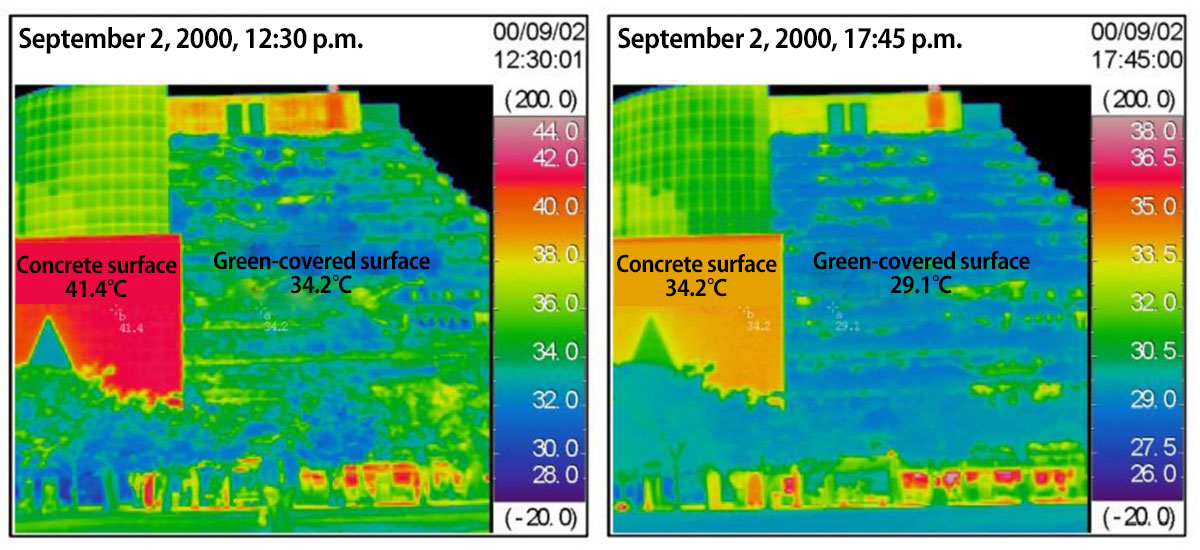
Thermal image (temperature change between midday and evening)
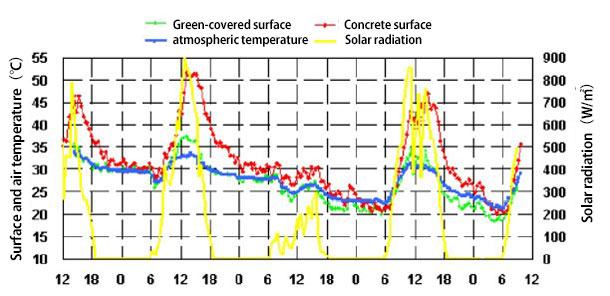
Change in surface temperature
In addition, from an analysis of data obtained by installing three-dimensional anemometers on the top, 10th, and 5th floors, it was determined that the Step Garden experiences downdrafts at night and updrafts during the day, and that the inclination of the wind is about 30 degrees, which is almost the same as the 34.5-degree slope of the Step Garden itself, demonstrating that the wind tends to follow the slope. Downdrafts form at night, when the wind is weak, due to radiative cooling that reduces the temperature of the surface of the vegetation. This effect can be attributed to the phenomenon of cold air currents in basins and on slopes; in this case cold air generated by the cooling of nearby air descends through the Step Garden, and these currents can be expected to bring cool breezes into the city center on tropical nights. (Please see the figure.)
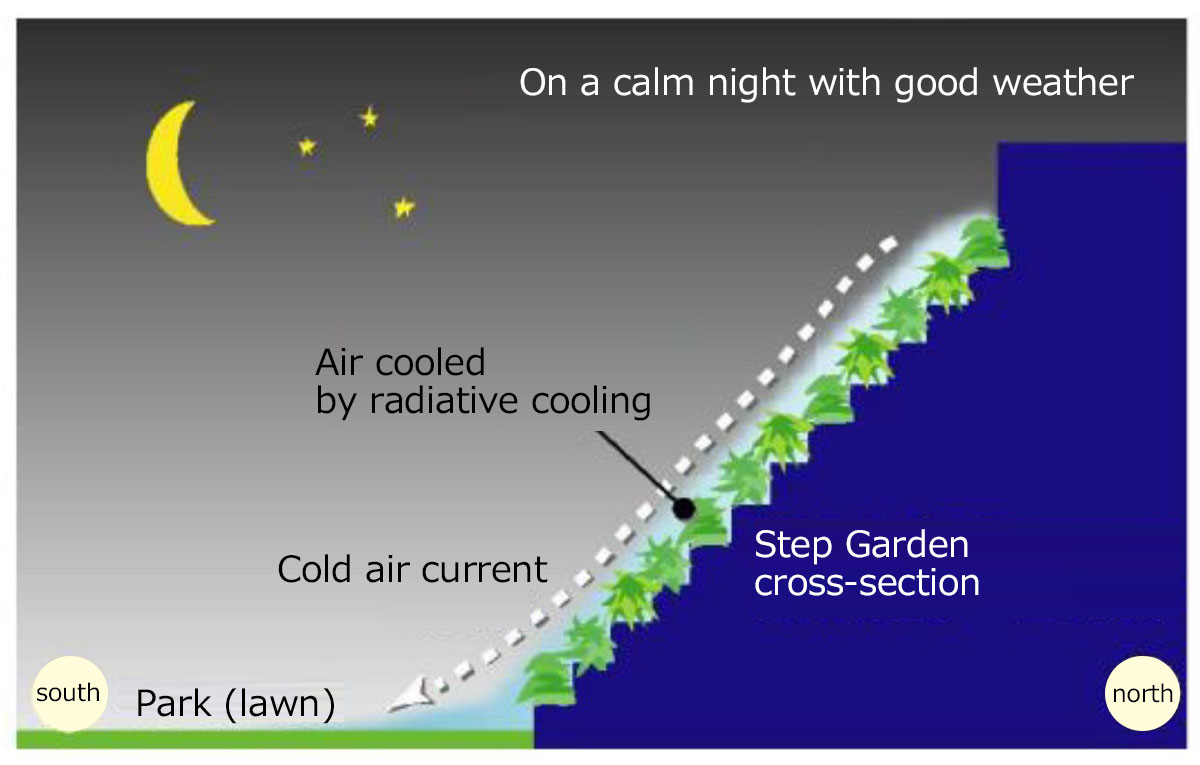
Please tell us about your future plans and aspirations.
Kawano: We want Mt. ACROS to be more widely known and used, and so we are intensifying our public relations activities. Although we restricted the number of visitors during the COVID-19 pandemic, we are now gradually accepting more visitors, including local elementary and junior high school students and university students who are interested in architecture. In addition, we are looking to increase our contribution to the local community and to the SDGs and to enhance ACROS Fukuoka’s value as a building through initiatives such as holding the Kyushu SDG Action Summit and SDG awareness-raising events for children, which will contribute toward achieving SDG Goal 11: “Make cities and human settlements inclusive, safe, resilient and sustainable”; Goal 13: “Take urgent action to combat climate change and its impacts”; and Goal 15: “Protect, restore and promote sustainable use of terrestrial ecosystems, sustainably manage forests, combat desertification, and halt and reverse land degradation and halt biodiversity loss.” We are also investigating the breeding of rhinoceros beetles, stag beetles, and other insects that children enjoy, and we hope to hold a variety of different events in the future.
Nose: We would like to invite all kinds of people, both adults and children, to experience the greenery of ACROS Fukuoka. In the beginning, 40% of the trees were evergreens, but we are planning to increase the number of deciduous trees in the future so that people can more fully experience seasonal changes. Through Mt. ACROS, we want to make people aware of the coolness and comfort that greening can provide in the summer, as well as of the attractions of biodiversity.

(Posted on December 28, 2022)

